Hoya Krimson Queen is a lovely variegated form of the Carnosa Hoya. This tropical vine has green, ovate leaves edged with white and pink.
The pink can come out strongly on a leaf when it first emerges. Then it might fade to a creamy white. Or stay some pink and white. It’s a pretty, ever-changing, display of color for your home.
Look forward to making a focal point with this beautiful lively plant.
All Hoya carnosas have pretty slow growing habits when compared to other vining plants like the Pearls and Jade Pothos or other fast growing vines.
However, The Krimson Queen Hoya grows faster than other Hoyas. It trails up to about six feet long indoors.
This vine is easily trellised, grown on a moss pole or left to trail. They make excellent hanging basket plants.
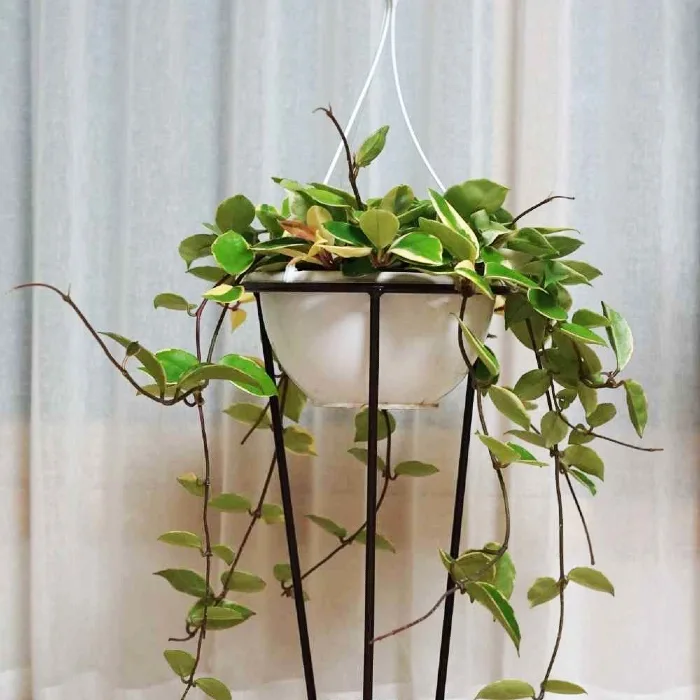
All Hoya Carnosa vines are easy care. But don’t completely neglect them. Read our care guide for this plant to learn what it needs.
You need to give them adequate indirect light, well draining soil and a regular watering schedule.
Once you understand Hoya Carnosa Krimson Queen it will be your plant friend for years and years.
Hoya Krimson Queen Vs Princess:
The queen and Princess are just two different variations on a theme.
- These are both cultivars of Hoya Carnosa.
- They are the same in colors.
- Care needs are the same
- growth patterns are the same
- They both flower
Where you will see the differences in is the leaf variegation.
Below is a close up of Krimson Princess and Krimson Queen. Notice the outer edges of the leaves are white in the Queen, on the right.
In Krimson princess (on the left), the white (or pink) in is the CENTER of the leaf and the outer edges stay green.
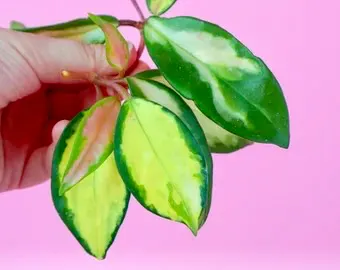
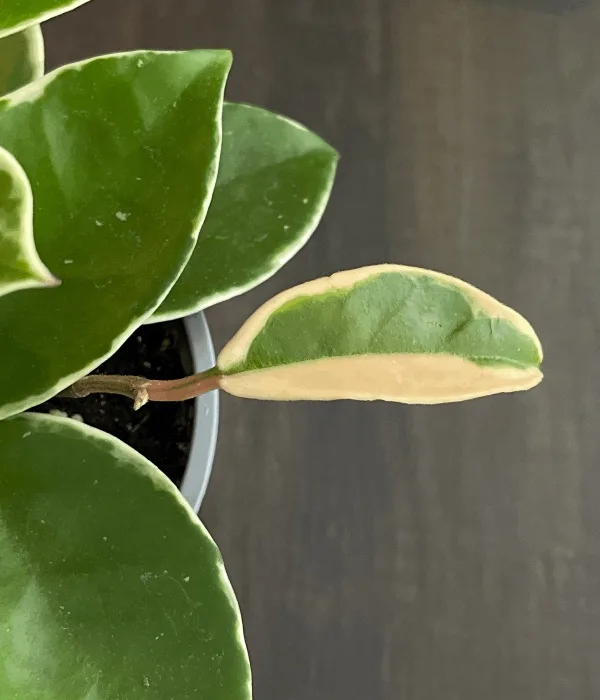
Hoya Krimson Queen variegation is reversed. The waxy leaf EDGES are white (or pink) and the center of the leaf is green.
To say that is an oversimplification.
Variegation in both these plants is quite diverse. The Variegations can cover the whole leaf or half leaf as you see above. And the plant variegation is light sensitive. They may revert to green leaves in low light conditions.
Nonetheless, look for these defining differences to determine which plant you have.
NOTE: You can see my Krimson Queen has small white dots of color on the green part of the leaves. This is splash or blister variegation. The Hoya Pubicalyx is fully variegated with splash. It is insignificant on the queen.
Flowering:
All Hoyas flower. Although they can take their time about it. The showy flower clusters are definitely worth the wait.
The hoya queen (Carnosa tricolor) will flower for you if it’s mature and happy in your care. Be patient.
Read our care guide at the bottom of this page to learn how to encourage your porcelain plant to flower.
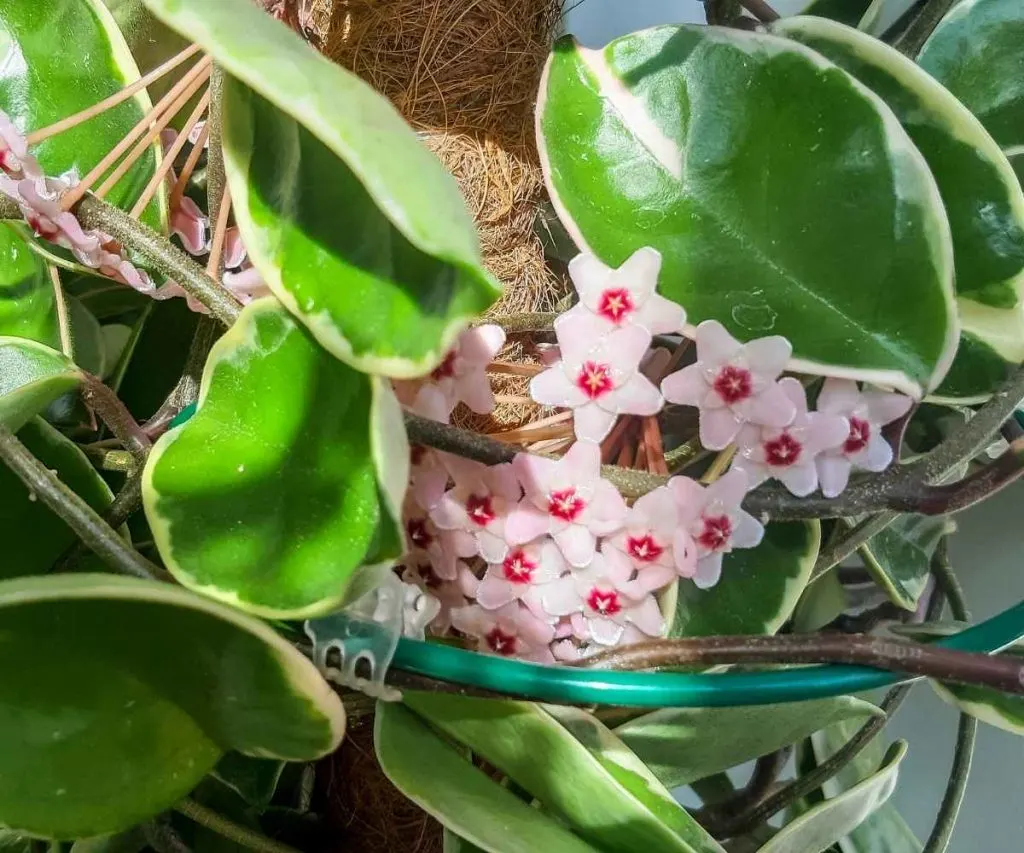
Hoya Krimson Queen Care Guide
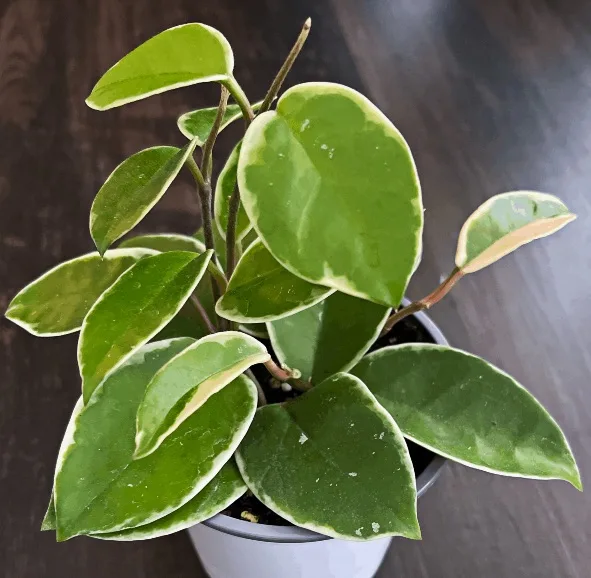
Hoya Carnosa Krimson Queen plants are slightly succulent vines with rounded leaves, strong stems and somewhat thick waxy leaves. These are fast growing, flowering vines with a sweet honey smell.
Carnosa vines enjoy trailing and can also be trellised. They grow to about four feet long.
This Hoya vine is easy care. However all hoyas are susceptible to root rot and mealy bugs. Pay particular attention to the watering needs of this plant.
Tools
Instructions
Soil Preference:
- This plant requires a light well draining soil mix. Hoyas cannot tolerate water logged soil compacted around the roots.
- A mix of potting soil, succulent soil mix and orchid soil mix (look for one with a lot of peat and finer bark mix) will keep the roots happiest.
- We use two parts potting soil to two parts succulent mix to two parts orchid bark. You can also use sand instead of bark if that is what you have.
- A heavy soil potting mix is not recommended for this plant.
- Due to this senstivity to over watering LECA growing is recommended. See our LECA Post series here.
Pot Size and Type:
- This plant needs a pot only an inch or two above the previous pot size. Chooosing too large a pot can encourage root rot.
- This Hoya will tolerate being root bound better than a roomy pot with too much soil. That will encourage wet conditions around the roots.
- Porous pots will work well for the Hoya. Terra cotta wicks away excess water from the soil. These plants enjoy a pot that breathes and keeps their feet dry.
- Repot every second year or when roots come out the drainage holes on the pot bottom.
Lighting:
- The Hoyas enjoys strong indirect light. It also appreciates direct light from a south or west facing window for four to six hours a day. Just watch high heat conditions.
- Shield this plant from strong direct light in summer south and west sunny windows. The leaves can burn in intense heat and light.
- Tips: Window sheers or blinds can offset longer periods of high direct light.
- In darker winter months the plant will most likely go dormant. If it appears to need more light you may find an indoor grow light helpful in darker climates.
Watering:
- Hoyas are VERY easy to overwater.
- Try a watering schedule of every week. Water thoroughly until the water runs out of the pot.
- Watering is best done on a regular schedule so the plant is not over or under watered. Both can cause stress on the plant.
- Never let this plant get wet feet. Hoya plants need to dry out between waterings. But the roots need hydrating too. for this reason I use a moisture meter and water when the root zone is almost or lightly in the dry zone.
- They cannot tolerate heavy compacted wet soil. If the soil is compacted the bottom of the soil can remain wet which encourages root rot and fungus gnats.
- Hoya roots need a lot of oxygen and will tolerate drier conditions.
- These plants are good candiates for growing in semihydroponics like LECA.
Humidity:
- Hoyas need humidity of 60 to 70% or more to be happy.
- TIPS: Set the container on a pebble tray with water under the pot or provide a humidifier to this tropical plant for best growth and happiness.
- Make sure you are not keeping your plant next to a heat or air vent. This will dramatically lower the humidity level.
- humidity also improves when you group plants together more closely.
- If the leaf tips go yellow or the leaves curl under on the edges. suspect humidity is too low.
How to Fertilize:
- Hoyas require regular fertilizing.
- Apply a good quality fertilizer (linked in materials) monthly through Spring and summer.
- Alternately you can use a slow release fertilizer at the beginning of the growing season.
- Decrease feedings by late Fall and allow the plant to rest through the winter months.
Temperature:
- Keep this plant at a low of 50 Degrees F. to upward of 85 Degrees F. It enjoys warmth and humidity.
Hoya Flowers:
- Hoya wax plants flower beautifully in bright clusters. You will love the honey sweet scent.
- Things to know about flowering.
- This plant grows flowers on umbels in clusters. The flowers are star shaped, small and fuzzy. They can vary in color but the flower cluster pictured below is typical for the Bella.
- Expect flowers on your Bella from May to September if it has the correct growing conditions.
- If your plant is not flowering move it to better light and fertilize it if it is otherwise healthy.
- One more thing. Hoyas flower on spurs. These are permanent features of your plant. Do NOT cut off the spurs. You will eliminate the flowering bodies on your Hoya.
- If you Notice nectar dripping off the flowers. This is normal. Don't let it concern you.
Pests:
- Hoyas can be attacked by pests. All sap suckers really enjoy the Hoya.
- Stress by longterm overwatering, poor light, extreme temperatures and soil conditions are contributors to plant stress..
- Spider mites, mealy bugs, scale, thrips and whitefly are the most common houseplant pests you will see.
- Learn How to get rid of aphids and other pests with our homemade pesticide soap recipe with neems oil.
- To minimize the possibility of pests be sure to check all nursery plants before bringing them home.
- Quarantine all new plants until you are sure no pests live in them.
How to Propagate:
- This plant is easily propagated through stem cuttings or air layering..
- Start with a healthy length of vine from your Hoya plant.
- Cut in the internodal zone. We show you how in the Pothos Propagation post
Hoya splash:
- Hoya splash is not true variegation. Rather it is Blister Variegation. This means the plant surface tissue raises in genetically controlled patterns. This causes a reflective look to the variegation.
- If you propagate this vine it will tend to revert to the original 'mother vine' blister variegation. So choose a good Splashy mother vine if you enjoy the splash. 🙂
Toxicity:
- This plant is petsafe.
- ALSO Hoya Plants Filter toxins out of the air in your home or office.
Notes
All hoya Carnosa plants have similar care needs. The video below will give you a quick general hoya care guide.
Related Content:
Follow Us:
Find us on YouTube, Instagram , Pinterest and TikTok! We love to Plant chat. We also comment, like and occasionally share your content to our daily stories. We’d love to see your plants. Share your joy in your houseplants. Happy Planting!
Recent Posts:
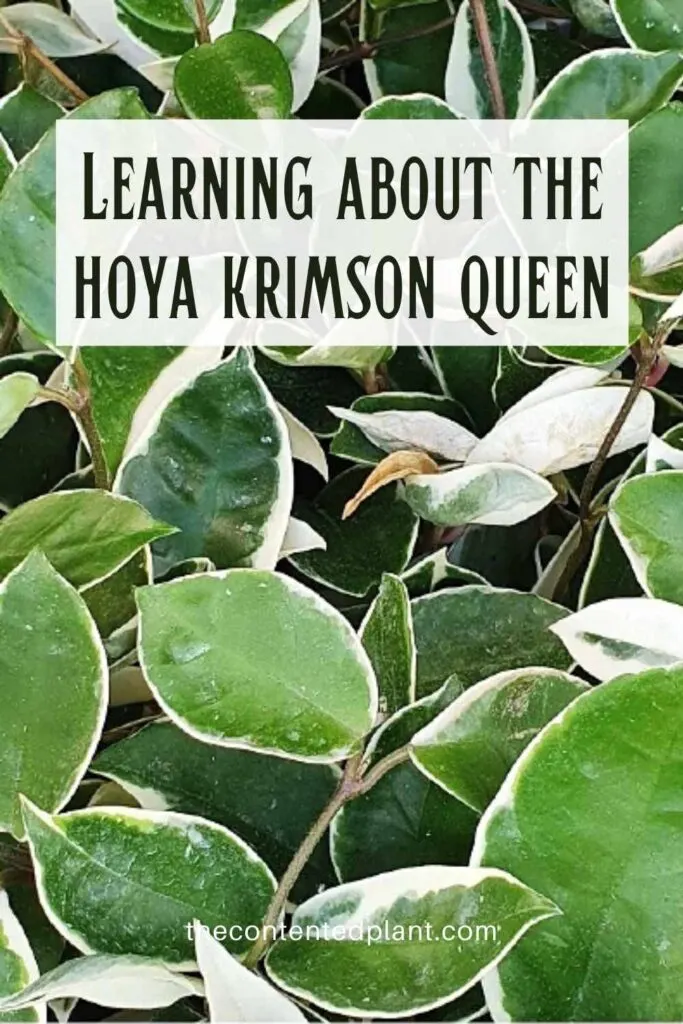

Baby Rubber Plant Profile-Peperomia Obtusifolia - The Contented Plant
Monday 14th of November 2022
[…] peperomia marble vine looks similar to a hoya with its thick trailing fleshy […]
Mold On Plant Soil-Is it harmful? How to Kill It - The Contented Plant
Sunday 6th of March 2022
[…] Hoya Krimson Queen Care guide […]